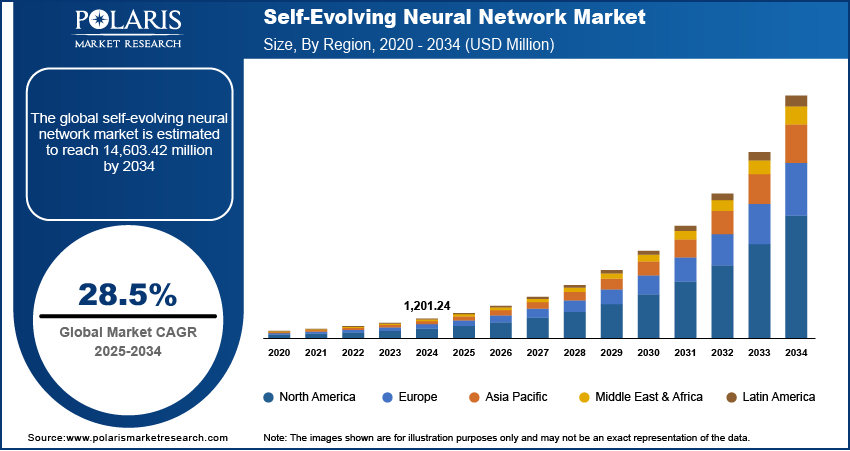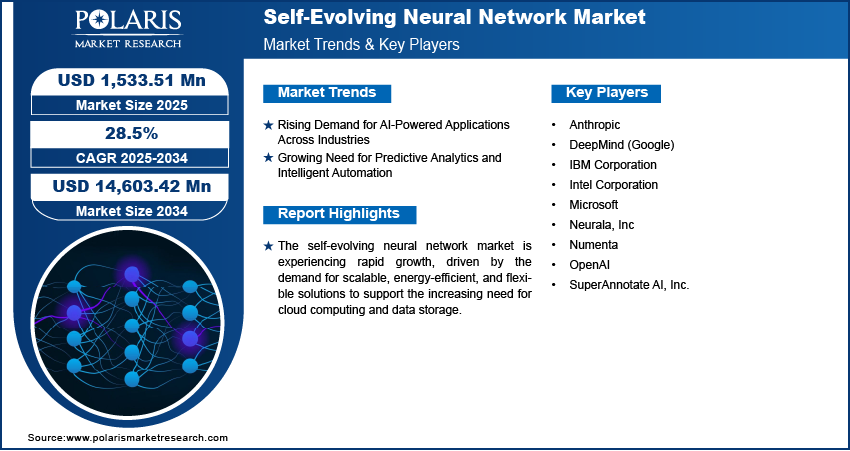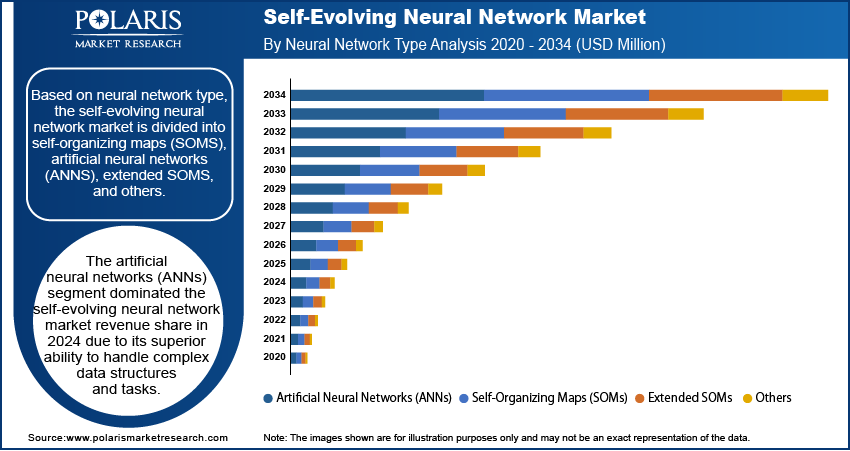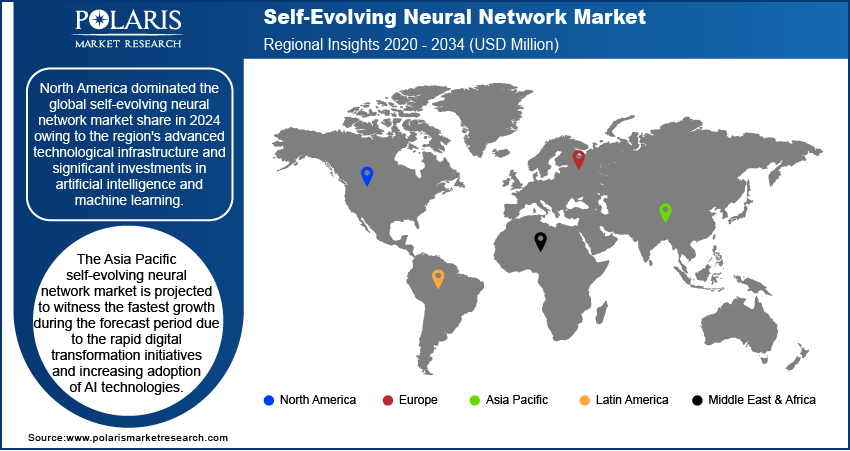
Self-Evolving Neural Network Market Size, Share, Trends, Industry Analysis Report: By Neural Network Type [Self-Organizing Maps (SOMs), Artificial Neural Networks (ANNs), Extended SOMs, and Others], Application, End Use, and Region (North America, Europe, Asia Pacific, Latin America, and Middle East & Africa) – Market Forecast, 2025–2034
- Published Date:Mar-2025
- Pages: 129
- Format: PDF
- Report ID: PM5439
- Base Year: 2024
- Historical Data: 2020-2023
Self-Evolving Neural Network Market Overview
The global self-evolving neural network market size was valued at USD 1,201.24 million in 2024. The market is expected to grow from USD 1,533.51 million in 2025 to USD 14,603.42 million by 2034, at a CAGR of 28.5% during 2025–2034.
A self-evolving neural network is an advanced form of artificial neural network that autonomously adapts and optimizes its architecture and parameters based on the data it processes. Technological advancements in deep learning algorithms, such as variational auto encoders (VAEs), primarily drive the self-evolving neural networks market growth. In March 2023, Microsoft integrated GPT-4 into Azure OpenAI Service, offering advanced AI models such as GPT-3.5, ChatGPT, and DALL•E 2. Azure provides enterprise-grade infrastructure, security, and compliance, allowing customers to build innovative AI applications responsibly and efficiently. These advancements have enabled neural networks to handle complex data patterns and tasks with greater accuracy and efficiency. Improved techniques such as reinforcement learning, transfer learning, and automated machine learning (AutoML) are empowering self-evolving networks to optimize their layers, nodes, and hyper parameters dynamically. As a result, organizations across various sectors are increasingly adopting these networks to gain deeper insights and improve decision making processes.

To Understand More About this Research: Request a Free Sample Report
Another driver accelerating the self-evolving neural network market demand is the increasing availability of big data and computing power. The expansion of IoT devices, digital platforms, and data-generating applications has led to an exponential rise in data volume. In July 2024, Vietnam’s Ministry of Information and Communications released a list of 103 digital platforms deployed by ministries to avoid duplication and promote nationwide use with an aim to enhance digital transformation, reduce costs, and improve operational efficiency across government agencies, contributing to the self-evolving neural network market development. Simultaneously, advancements in high-performance computing, cloud infrastructures, and GPUs have provided the computational resources necessary to process this vast data efficiently. Self-evolving neural networks leverage this data and computational power to continuously learn, adapt, and refine their models without human intervention, making them highly valuable for predictive analytics, anomaly detection, and real-time decision-making in various industries such as finance, healthcare, and telecommunications.
Self-Evolving Neural Network Market Dynamics
Rising Demand for AI-Powered Applications Across Industries
AI-powered solutions have become indispensable as businesses aim to improve customer experiences, streamline operations, and gain a competitive edge. Self-evolving neural networks, with their ability to autonomously adjust and optimize themselves, offer a powerful foundation for these applications. They allow real-time data processing and adaptive learning, making them ideal for tasks such as personalized recommendations, fraud detection, and natural language processing. In September 2023, Ambiq launched its neural network speech enhancement (NNSE), an open-source AI model for IoT applications. It enables real-time noise reduction with minimal latency and energy consumption, simplifying deployment on Apollo4 Plus SoC built on Ambiq’s neuralSPOT AI development kit. This adaptability improves the accuracy and efficiency of AI systems and also reduces the need for constant human intervention, driving their adoption across numerous sectors such as finance, healthcare, retail, and manufacturing. Hence, the increasing demand for AI-powered applications across industries fuels the self-evolving neural network market growth.
Growing Need for Predictive Analytics and Intelligent Automation
Organizations are increasingly focused on leveraging predictive insights to forecast trends, optimize resources, and mitigate risks. Self-evolving neural networks excel in predictive analytics by continuously learning from new data, identifying patterns, and adjusting their parameters to improve forecasting accuracy. In February 2023, AVEVA launched its latest predictive analytics software for industrial asset monitoring. The release features automated model building, enabling faster deployment, improved accuracy, and better decision-making for asset reliability and sustainability. Additionally, their capability to automate decision-making processes with minimal supervision aligns seamlessly with the rising trend of intelligent automation. These networks help businesses reduce operational costs and enhance efficiency by enabling more accurate predictions and automated responses, further fueling the self-evolving neural network market expansion.

Self-Evolving Neural Network Market Segment Insights
Self-Evolving Neural Network Market Assessment by Neural Network Type Outlook
The global self-evolving neural network market segmentation, based on neural network type, includes self-organizing maps (SOMS), artificial neural networks (ANNS), extended SOMS, and others. The artificial neural networks (ANNs) segment dominated the market share in 2024 due to its superior ability to handle complex data structures and tasks. ANNs, with their multi-layered architecture and backpropagation capabilities, excel at identifying intricate patterns within large datasets. Their adaptability and accuracy in tasks such as image recognition, natural language processing, and anomaly detection have made them the preferred choice for industries seeking advanced AI solutions. Additionally, the continuous improvements in training algorithms and computational power have further enhanced the performance and scalability of ANNs, driving their dominance in the market.
Self-Evolving Neural Network Market Evaluation by Application Outlook
The global self-evolving neural network market segmentation, based on application, includes customer clustering, data mining, personalization, demand forecasting, and others. The demand forecasting segment is expected to witness the highest growth rate during the forecast period, driven by the increasing need for accurate and timely predictions in supply chain management, retail, and finance. Self-evolving neural networks, with their ability to learn autonomously and adjust parameters based on new data, offer superior accuracy in forecasting demand patterns and trends. Their ability to process large volumes of historical and real-time data allows businesses to optimize inventory levels, reduce costs, and improve decision-making. This growing emphasis on data-driven insights is propelling the adoption of self-evolving neural networks for demand forecasting across various industries.

Self-Evolving Neural Network Market Regional Analysis
By region, the report provides self-evolving neural network market insights into North America, Europe, Asia Pacific, Latin America, and the Middle East & Africa. North America dominated the self-evolving neural network market revenue share in 2024 owing to the region's advanced technological infrastructure and significant investments in artificial intelligence and machine learning. The presence of major AI solution providers, coupled with substantial R&D funding, has accelerated the adoption and growth opportunities of self-evolving neural networks across industries such as finance, healthcare, and telecommunications. In March 2024, Akamai Technologies collaborated with Neural Magic to improve deep learning capabilities on Akamai’s distributed computing infrastructure. The collaboration enables efficient AI workload execution on CPU-based servers, offering enterprises a high-performance platform for deep learning applications. Additionally, favorable government policies and a high concentration of skilled professionals have further supported the growth of this market in North America, making it a leader in the deployment of advanced AI technologies.

The Asia Pacific self-evolving neural network market is projected to witness the fastest growth during the forecast period primarily due to the rapid digital transformation initiatives and increasing adoption of AI technologies in countries such as China, Japan, and India. The expansion of e-commerce, financial services, and smart city projects has generated a vast amount of data, creating demand for self-evolving neural networks to process and analyze this data efficiently. Furthermore, growing investments in AI research and the rising focus on automation and predictive analytics are anticipated to drive the adoption of these networks across Asia Pacific.
Self-Evolving Neural Network Market Players & Competitive Analysis Report
The self-evolving neural network market is highly competitive, with global leaders and regional players focusing on innovation, strategic alliances, and regional expansion. Global players leverage strong R&D capabilities, technological advancements, and extensive distribution networks to deliver advanced AI solutions, addressing the rising demand for autonomous learning systems. Key trends include the adoption of reinforcement learning, automated machine learning (AutoML), and digitalization, driven by economic growth and evolving regulatory frameworks. Strategic investments, mergers and acquisitions, and joint ventures are pivotal for enhancing market positioning and expanding footprints. Meanwhile, regional players focus on cost-effective and customized AI solutions to meet localized demands. Competitive benchmarking involves market entry assessments and partnership ecosystems to cater to the need for innovative AI-driven solutions. Technological advancements such as AI model optimization and cloud-based deployments are reshaping the industry landscape. Pricing insights, revenue growth analysis, and competitive intelligence are crucial for identifying growth opportunities and ensuring long-term profitability. In summary, the self-evolving neural network market growth is propelled by technological innovation, strategic developments, and a focus on sustainability and adaptability in a highly competitive global market. A few key major players are Anthropic; DeepMind (Google); IBM Corporation; Intel Corporation; Microsoft; Neurala, Inc.; Numenta; OpenAI; and SuperAnnotate AI, Inc.
DeepMind, a subsidiary of Alphabet Inc., is an artificial intelligence (AI) research company founded in 2010 and acquired by Google in 2014. It specializes in creating advanced AI systems using deep learning, reinforcement learning, and neural networks to tackle complex problems. DeepMind gained global recognition with AlphaGo, the first AI to defeat a world champion in the board game Go, and its successors, such as AlphaZero and MuZero, extended these capabilities to other games and real-world challenges. The company also improves energy efficiency in data centers and powers tools such as Google Assistant and YouTube optimization. Its self-evolving neural networks use convolutional architectures inspired by the human brain, enabling the AI to learn autonomously from raw data without explicit programming. DeepMind aims to responsibly develop artificial general intelligence (AGI) that benefits humanity, addressing challenges such as robotics, speech recognition, and mathematical problem-solving by combining cutting-edge machine learning with scientific diligence.
Microsoft, a multinational technology company headquartered in Redmond, Washington, has been exploring advancements in self-evolving neural networks, a subset of neuroevolution, which uses evolutionary algorithms to optimize artificial neural networks (ANNs). This approach allows networks to autonomously adapt their structure and parameters, bypassing traditional gradient-based methods. A key methodology in this field is NEAT (NeuroEvolution of Augmenting Topologies). It starts with minimal network structures and evolves them by adding nodes and connections over time, ensuring efficiency and adaptability. Self-evolving networks leverage genetic algorithms to simulate natural selection, where "fitter" models performing better on tasks are retained and improved through crossover and mutation. These processes enable the creation of more robust architectures capable of solving complex problems without predefined topologies. Microsoft's research integrates such neuroevolutionary approaches with cutting-edge AI advancements, such as large language models (LLMs) and multimodal systems. These networks can dynamically balance exploration and exploitation, optimizing performance across diverse tasks by combining self-adaptive mutation mechanisms with population-based search methods. This innovation aligns with Microsoft's broader AI initiatives, such as enhancing reasoning capabilities in LLMs and developing multimodal AI systems such as Composable Diffusion for synchronized outputs across text, audio, and visuals.
List of Key Companies in Self-Evolving Neural Network Market
- Anthropic
- DeepMind (Google)
- IBM Corporation
- Intel Corporation
- Microsoft
- Neurala, Inc
- Numenta
- OpenAI
- SuperAnnotate AI, Inc.
Self-Evolving Neural Network Industry Developments
February 2024: Siemens improved its Senseye Predictive Maintenance solution with generative AI, enabling conversational user interfaces for more instinctive and efficient proactive maintenance.
Self-Evolving Neural Network Market Segmentation
By Neural Network Type Outlook (Revenue, USD Million, 2020–2034)
- Self-Organizing Maps (SOMs)
- Artificial Neural Networks (ANNs)
- Extended SOMs
- Others
By Application Outlook (Revenue, USD Million, 2020–2034)
- Customer Clustering
- Data Mining
- Personalization
- Demand Forecasting
- Others
By End Use Outlook (Revenue, USD Million, 2020–2034)
- Telecommunications
- Retail
- Healthcare
- Finance
- Others
By Regional Outlook (Revenue, USD Million, 2020–2034)
- North America
- US
- Canada
- Europe
- Germany
- France
- UK
- Italy
- Spain
- Netherlands
- Russia
- Rest of Europe
- Asia Pacific
- China
- Japan
- India
- Malaysia
- South Korea
- Indonesia
- Australia
- Vietnam
- Rest of Asia Pacific
- Middle East & Africa
- Saudi Arabia
- UAE
- Israel
- South Africa
- Rest of Middle East & Africa
- Latin America
- Mexico
- Brazil
- Argentina
- Rest of Latin America
Self-Evolving Neural Network Market Report Scope
|
Report Attributes |
Details |
|
Market Size Value in 2024 |
USD 1,201.24 million |
|
Market Size Value in 2025 |
USD 1,533.51 million |
|
Revenue Forecast in 2034 |
USD 14,603.42 million |
|
CAGR |
28.5% from 2025 to 2034 |
|
Base Year |
2024 |
|
Historical Data |
2020–2023 |
|
Forecast Period |
2025–2034 |
|
Quantitative Units |
Revenue in USD Million and CAGR from 2025 to 2034 |
|
Report Coverage |
Revenue Forecast, Market Competitive Landscape, Growth Factors, and Industry Trends |
|
Segments Covered |
|
|
Regional Scope |
|
|
Competitive Landscape |
|
|
Report Format |
|
|
Customization |
Report customization as per your requirements with respect to countries, regions, and segmentation. |
FAQ's
The global self-evolving neural network market size was valued at USD 1,201.24 million in 2024 and is projected to grow to USD 14,603.42 million by 2034.
The global market is projected to register a CAGR of 28.5% during the forecast period.
North America dominated the market revenue share in 2024.
The Asia Pacific self-evolving neural network market is projected to witness the fastest growth during the forecast period primarily due to the rapid digital transformation initiatives and increasing adoption of AI technologies
A few of the key players in the market are Anthropic; DeepMind (Google); IBM Corporation; Intel Corporation; Microsoft; Neurala, Inc.; Numenta; OpenAI; and SuperAnnotate AI, Inc.
The artificial neural networks (ANNs) segment dominated the market share in 2024.
The demand forecasting segment is expected to witness the fastest growth during the forecast period.
